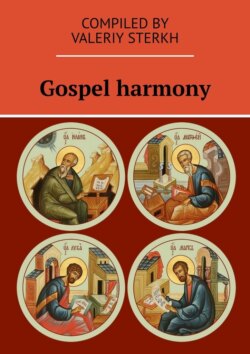Читать книгу Gospel harmony - Valeriy Sterkh - Страница 15
Part 2. Comparing the Gospels
The birth of Jesus
ОглавлениеThe account of Jesus’ childhood is found in both Matthew and Luke. But they tell the story differently.
According to Matthew, the events happened in the following order:
The angel announces the birth of Jesus to Joseph (Mt 1:18—25; UG 8). Jesus is born in Bethlehem, and the Magi come to worship him (Mt 2:1—12; UG 14). Jesus’ family flees to Egypt to escape the wrath of Herod (Mt 2:13—15; UG 15). The massacre of the innocent takes place near Bethlehem (Mt 2:16—18; UG 16). The holy family returns from Egypt and settles in Nazareth (Mt 2:19—23; UG 17).
According to Luke, things happened as follows:
Gabriel announces the birth of Jesus to Mary (Lk 1:26—38; UG 4). Joseph takes his pregnant wife from Nazareth to Bethlehem to participate in the census; Jesus is born (Lk 2:1—7; UG 9). The angel announces the birth of Jesus to the shepherds (Lk 2:8—14; UG 10). The shepherds come to worship Jesus (Lk 2:15—20; UG 11). Jesus is circumcised and named Jesus (Lk 2:21; UG 12). The days of purification; Jesus is brought to the temple (Lk 2:22—38; UG 13). Jesus’ family returns to Nazareth (Lk 2:39; UG 17).
In Matthew, the birth of Jesus is announced to Joseph by the angel of the Lord, but in Luke, the prophecy of Jesus’ birth is announced to Mary by the archangel Gabriel. These are two different annunciations, separated by some time. First, Gabriel appeared to Mary and announced to her that she would conceive from the Holy Spirit (Lk 1:26—38; UG 4). Then she became pregnant, and Joseph found out about it. Next, the angel of the Lord, most likely Gabriel, appeared to Joseph to announce the birth of Jesus and encourage him to accept Mary and her son (Mt 1:18—25; UG 8).
Luke describes Jesus’ family traveling from Nazareth to Bethlehem to participate in the census, and then Mary gives birth to Jesus (Lk 2:1—7; UG 9). Matthew does not give us much detail about the birth of Jesus in Bethlehem (Mt 2:1). Here we see the agreement between the two Gospels.
The subsequent narratives in Matthew and Luke split ways, but they can, nevertheless, be connected by putting the events in chronological order:
The angel announces the birth of Jesus to the shepherds (Lk 2:8—14; UG 10). The shepherds worship Jesus (Lk 2:15—20; UG 11). Jesus is circumcised and named Jesus (Mt 1:25; Lk 2:21; UG 12). The days of purification; Jesus is brought to the temple (Lk 2:22—38; UG 13). The Magi worship Jesus (Mt 2:1—12; UG 14). Jesus’ family flees to Egypt (Mt 2:13—15; UG 15). The massacre of the innocent (Mt 2:16—18; UG 16). Return from Egypt, settling in Nazareth (Mt 2:19—23; Lk 2:39; UG 17).
If you read only Luke’s Gospel, you might get the impression that Jesus’ family went straight from Jerusalem to Nazareth. Matthew, however, says that they first went to Egypt. This seeming contradiction can be explained as follows. Luke writes, «And when they had performed all things according to the law of the Lord, they returned into Galilee, to their own city Nazareth» (Lk 2:39). Matthew talks about the flight to Egypt as a means of fulfilling the prophecy of Scripture: «That it might be fulfilled which was spoken of the Lord by the prophet, saying, out of Egypt have I called my son» (Mt 2:15; compare Hos 11:1). We may well regard the expression «according to the law of the Lord» as «fulfilling the prophecy of the law of the Lord (Scripture)». So, we can easily harmonize these two episodes.
